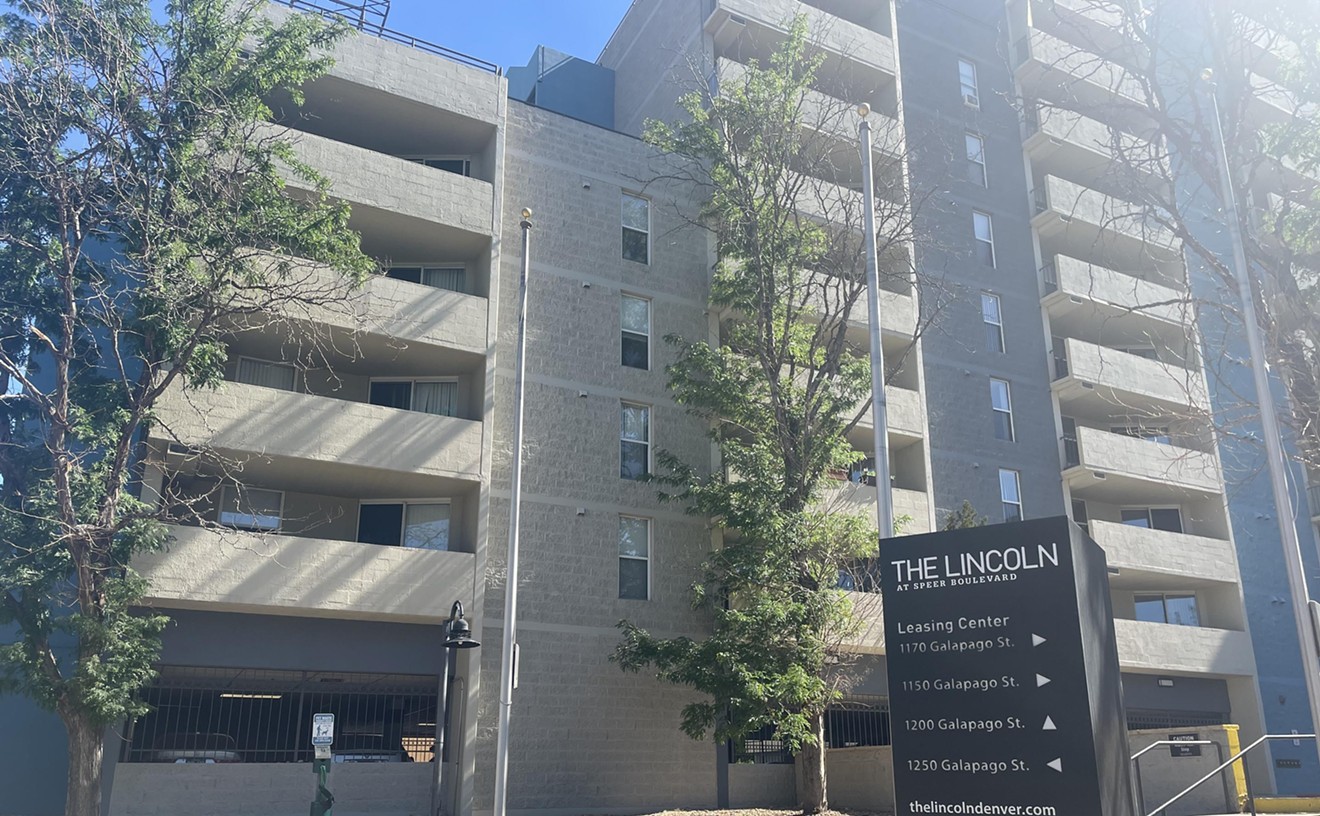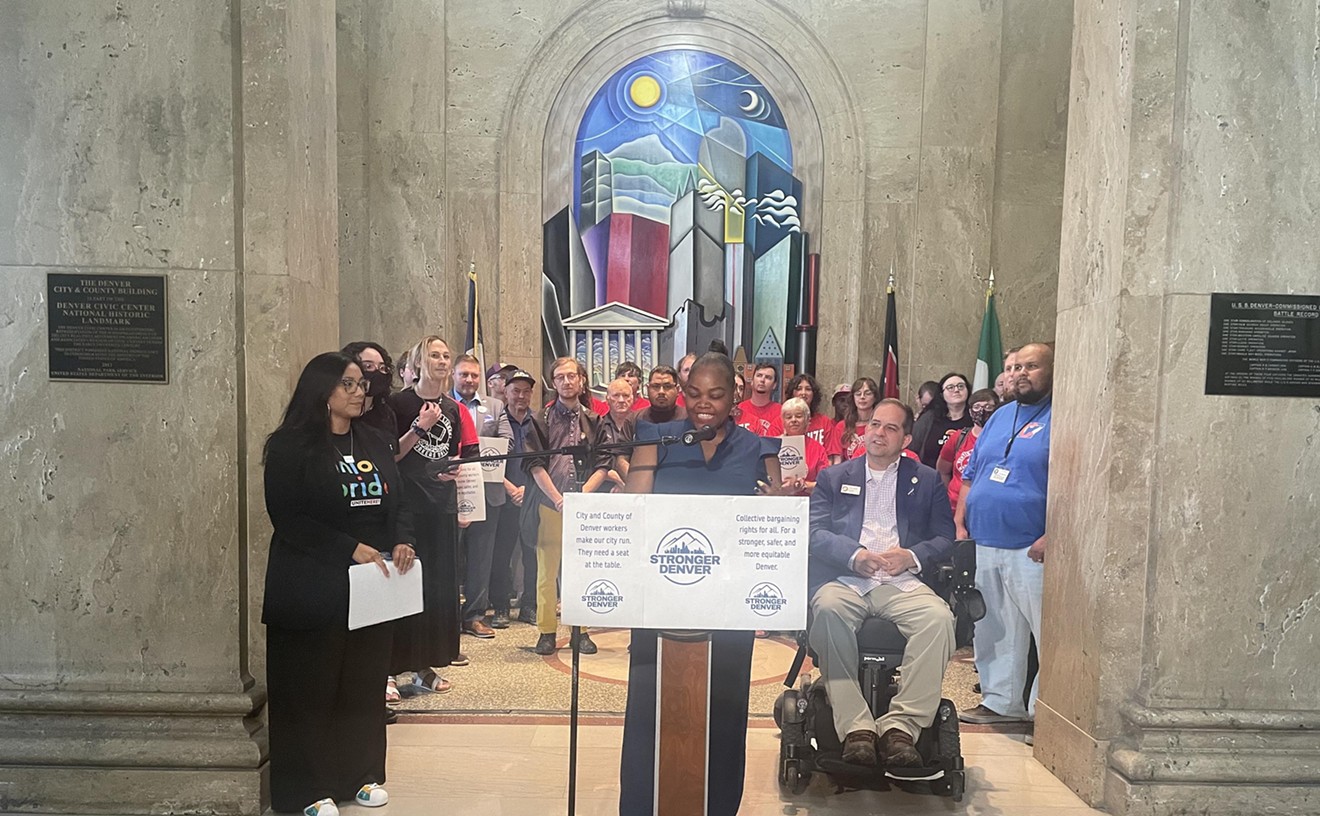Brogan learned that the man had been sleeping on the streets because he didn’t feel safe in Denver’s shelters; every time he stayed in one, he was robbed or beaten. He said he’d lost three cell phones to thieves. As they spoke, Brogan thought of how much the man reminded her of her grandfather. And the personal connections didn’t end there.
Brogan is a peer navigator with the Denver Public Library. She and three other peer navigators were hired in January 2017; the Colorado Mental Wellness Network received grants from the U.S. Department of Justice to fund the navigator program, which works with the homeless and mentally ill visitors among the 2,300 people that the Central branch sees a day.
Trained and overseen by the Network, the navigators are not social workers — at least not in the traditional sense. As their title implies, peer navigators help people with whom they share experiences connect — to society with a simple conversation, or to social services, including housing, substance-abuse treatment and health care.
Along with two social workers, the peer navigators are helping the Central branch, a prime hangout for the homeless, as well as all of the branch libraries in the system adjust to their changing role in the community while also staying true to the library’s mission of helping people who are seeking answers. In a city struggling with an ever-growing homeless population and increasing substance-abuse issues, there are more questions than ever.
Brogan might not have experienced homelessness to the degree that the man living in back of the Athmar Park library had. But she saw in him a helplessness that was all too familiar.
After an injury curbed Brogan’s twenty-year career as a massage therapist, she became depressed. In addition to losing her job, she lost her home. She was at a low point when an employment specialist said that her life experiences made her uniquely qualified to become a peer navigator, a relatively new segment of the social-work field.
“It’s a great thing that something so terrible as having a nervous breakdown makes you qualified for a job,” Brogan says. “I’ve navigated all these systems for myself and bumped my head into the wall and found ways around things. I’m able to use that knowledge as well as just having that complete empathy with the other person.”
Using that knowledge, Brogan connected the man from Athmar with the Colorado Coalition for the Homeless.
The next time she heard about him was at the end of February, on a day just as blustery as that night in October. Brogan learned through one of the library’s social workers that not only had the man found housing, but his cognition had improved because he had finally gotten his diabetes under control.
When she’d met the man in October, Brogan had considered her actions inconsequential. “I thought that was nothing, a drop in the bucket,” she says. “But I realize now that connection was part of [his rehabilitation]. The Coalition came out and started helping him, and that started his process of coming back into housing and having a life not living by a dumpster. That’s why I do what I do.”

Peer navigators Cuica Montoya and Jonathan Strauss use their life experiences to help others.
Anthony Camera
The peer navigators wear the struggles they’ve survived like badges of honor. Brogan knows what it’s like to feel utterly hopeless. Jonathan Strauss lives with bipolar disorder. Cuica Montoya is a formerly homeless drug addict who used to hang out at the Central branch back when she had nowhere to go during the day. Sarah Humble is a bipolar drug addict.
Sitting across from the peer navigators is Elissa Hardy, the library’s lead social worker for the past three years, and Kristi Schaefer, a social worker hired at the beginning of 2016.
Before she came to the library, Hardy worked with the Colorado Coalition for the Homeless for nearly ten years, then as a social worker in Evergreen. Tired of the commute, she was looking for other opportunities when a friend sent her a job posting for a social worker at DPL’s Central branch. “I’d never heard of social work in libraries,” she says.“People come to the library for many reasons. There are books, resources. But it’s also a shelter. It keeps people dry, safe and warm.”
tweet this
Before Hardy took her job in 2015, only a handful of library systems in the country employed social workers. The first, San Francisco’s system, made its first hire in 2009. Now some thirty library systems across the country have at least one social worker on staff.
Free to access and open to all, libraries are increasingly doubling as day shelters for the homeless, whose population was about 5,112 in the seven-county metro Denver region last year, the most recent figure available.
They come for shelter — the guards won’t bug them or tell them to move along if they aren’t doing anything wrong — but also for access to the 122 computers on the fourth floor; the Community Technology Center offers computer-literacy classes that range from basic, like how to work a mouse, to advanced, including lessons in coding.
“People come to the library for many reasons,” Hardy says. “There are books, resources. But it’s also a shelter. It keeps people dry, safe and warm.”
Michelle Jeske, who became Denver’s city librarian in 2015, says no single incident led the library to add social workers to its 300-member staff at the Central branch. Instead, it was a gradual realization that perhaps, as Denver’s homeless population continued to increase, the library had to expand its services for struggling visitors, as well as start educating staff through regular workshops and classes about dealing with the homeless and mentally ill.
“We were kind of getting to the point where we realized that we didn’t necessarily have the right staffing sometimes to support people experiencing certain life challenges. Sometimes people ask me if this is ‘mission creep,’” Jeske explains, referring to a shift in priorities that can lead an institution astray, “and I say absolutely not. If you think about it, a social worker is a very specialized librarian. That’s the way I think about it.”
Some libraries take a different approach.
In 2015, not long before Seattle declared a state of emergency for its homeless crisis, the Seattle Public Library implemented a long list of rules of conduct; violations include creating loud noises, entering the library barefoot, “appearing to be sleeping” in the library and using restrooms for grooming. In 2016, the library brought on a community-resource specialist trained in emergency services to help the library’s homeless visitors. That position no longer exists.
Her first year on the job, Hardy connected with 434 visitors. In 2016, she and Schaefer helped nearly 1,265. Last year, with peer navigators added to the team, they assisted 3,501 visitors.
“It’s not so much that there were more people coming in,” says Hardy. “It was more that we had the availability to make those contacts.”
But even the nature of the contacts has changed since the peer navigators came on board.
Trained social workers, Hardy and Schaefer manage a list of clients, helping them maneuver the steps necessary to achieve what they need, be it housing or substance-abuse treatment. Before the peer navigators were hired, they also dealt with a lot of crisis situations involving library visitors.
“But our numbers shifted once we got the peer navigators because they’re having so much more contact, so we’re moving out of crisis to solution,” Hardy says.
Now, if someone in distress walks into the library, a peer navigator will try to talk with the person to de-escalate any potential confrontation, knowing firsthand what it feels like to be in a strange head space.
From there the peer navigator will work with any willing clients on a plan to move from crisis to stability.
“I like making up game plans, because I know how overwhelming it is when you’re experiencing homelessness to even start the process of getting out of the situation you’re in,” says Montoya. “It’s just about being there and letting them know we’re here, and figuring things out.”
The peer navigators each have their own version of a successful day at work. But they all count any interaction, no matter how small or impactful, as a win.
If a particularly hardened-looking individual visits the library, Strauss knows it’s entirely likely that he hasn’t been acknowledged by another human in a while. So he makes it a point to say hello. Eventually, sometimes, the person might say hello back. On his first day, Strauss helped a man whose hands were so frozen that he couldn’t move his fingers to open a bag of peanuts. “He was so grateful to just have someone who could open the peanuts,” Strauss remembers.
There are big success stories, too, like the visitor struggling with alcoholism that all four navigators helped secure housing, or the client who told Montoya it was because of her that he got into rehab.
A bad day is different to each navigator, too. Strauss recalls the time a severely mentally ill visitor tried to convince him he needed to put every cell phone under surveillance. “Sometimes there are just some people you can’t help,” he says. Unless that person is violent or inciting chaos, though, the peer navigator will talk with them until they choose to leave of their own volition.
The peer navigators agree that they consider their day a failure if they don’t talk to a single client or are unable to find resources to help a client. For example, Denver doesn’t have any on-demand drug treatment, even for those who can afford it. And even obvious solutions to problems aren’t always the best.
“Working with people who are extremely vulnerable, the first step is we need to get them into somewhere that feels safe,” says Strauss. “For a lot of people, that isn’t the shelter. Even managing the shelter system isn’t easy. And you’re expecting someone who’s experiencing homelessness to do that?”
The peer navigators help more than just troubled visitors. Librarians and staffers who man help desks, which are primarily equipped to check out library items and answer questions about the facilities, are often the first stop for people who need help beyond finding a book. Untrained in social services, these employees might not have the right answers. Now they have six ways to connect people to the services they need.
“Librarians love helping people find things,” Hardy says.
Hardy and Schaefer have implemented “Homelessness 101” programs that teach staff about the needs of struggling guests while humanizing them at the same time. And a new coffee-and-doughnuts meetup at different branches lets staffers share a morning snack and converse with visitors.
“Before this, they only got to interact with customers experiencing homelessness when there was a problem, which can only reinforce biases and stereotypes,” says Schaefer.

The library will hire two more social workers to assist visitors at its 25 other branches.
Anthony Camera
Hardy says the library had been talking about the overdoses long before the reporters caught on to the story. For example, the staff had already been discussing equipping librarians with Narcan, which can revive someone who is overdosing; in late February 2017, six Narcan kits were distributed to staff.
The media attention at least helped convince naysayers that the library’s social workers and peer navigators were not only practical, but necessary. The library is hiring two more social workers who will work primarily at the library’s 25 other branches, and after grants for the peer navigators end this summer, the library will kick in funds to keep them through the year. (A library spokesman says it’s still looking for grants to help continue funding the positions.)
Jeske understands that the general public might not understand the library’s emphasis on outreach to the homeless, the drug-addicted and the mentally ill. Sit at the Central branch long enough, and the tension between the transient and homeless visitors and everyone else is palpable. But Jeske sees the social workers and peer navigators as an extension of what librarians already do.
“Librarians connect people to information directly or refer people to appropriate resources, sometimes outside the library,” she says. “That’s really what social workers do, but with a different skill set and a different bank of knowledge around particular resources for a particular population.”
For Hardy and Schaefer, the library has moved far beyond the stereotype of a quiet gathering space for bookworms and bossy women constantly shushing people. For them, the library is a living organism, a gathering place, whatever the community needs it to be.
Schaefer recalls standing outside the Central branch during the recent eclipse. “Everyone, guys in suits, people experiencing homelessness, were looking at the sky through these glasses,” she says. “It was incredible to watch everyone come together at this place.”
When Hardy travels now, she likes to visit libraries.
“I love that there’s this place in any city...where anybody can just be,” she explains. “It’s free and equal access to all. It’s the only public place in the world where you don’t need a reason to be there.”
















